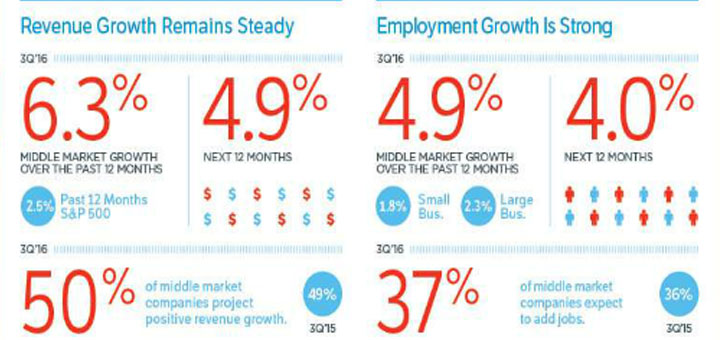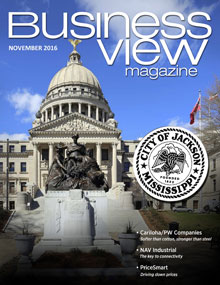As revenue holds steady with broad industry-wide improvements in employment, executives note confidence in U.S. and global economies
A major driving force in the United States economy, the middle market delivers above its own expectations year over year. Middle market companies – those with annual revenues between $10 million and $1 billion – provide roughly one third of the United States’ total employment and GDP. As an individual market segment, it is comparable to the economies of Germany and Japan.
Employment grew at a rate of nearly five percent in the third quarter of 2016 at U.S. middle market companies, according to a new study from the National Center for the Middle Market (NCMM). The annualized employment growth rate of 4.9 percent was the highest level observed across the middle market in nearly two years. In addition, all industries except manufacturing reported increases from Q2 numbers. This occurred as overall revenue growth held steady (6.3 percent) to its historical average of 6.4 percent.
“While companies continue to outpace their year-over-year expectations, revenue growth seems to be settling in at more moderate levels and is in line with long-term averages,” said Thomas A. Stewart, executive director of the NCMM. “The real news this quarter is the jump in employment growth amid expectations for further workforce increases.”
The third quarter Middle Market Indicator (MMI) outlines the sector’s economic performance and outlook. The results come from a survey of more than 1,000 C-suite executives at middle market firms, defined as companies with annual revenues between $10 million to $1 billion.
Middle market executives’ confidence in the U.S. and their local economies remains high and essentially unchanged, with 72 percent and 80 percent expressing confidence in each, respectively. Confidence in the global economy has risen to 56 percent, breaking out of a year-long slump that saw global confidence dip to about 50 percent.
Talent management, most commonly workforce growth and retention, continues to be a key area for improvement as cited by executives – 39 percent of respondents identify talent management as a top internal challenge. Despite the overall increase in employment numbers, 17 percent still say their current workforce size is insufficient for market conditions.
Responding to increases in workforce demands, companies are providing high-quality jobs, placing more than three-quarters of Q3 hires in full-time positions. Executives elaborated on their hiring priorities, most commonly naming operations, marketing and IT departments as key areas for recruitment.
“The tide has come in for middle market hiring, with employment growth up from 3.6 percent six months ago to a rate of 4.9 percent today,” said Stewart. “Interestingly, the rate of hiring is growing faster than the rate of revenue growth. Whether we’ll see this trend continue or it’s simply the middle market playing ‘catch up’ to last quarter’s remarkable revenue numbers, it’s good news for workers.”
Middle market companies are monitoring their costs carefully. The average company anticipates costs rising just 2.1 percent while profit margins are projected to expand 3.1 percent over the next year. More than one-third of companies expect to achieve modest price increases on their products and services.
The top three cost concerns for executives are rising interest rates, healthcare, and energy. While the Fed signals an oncoming rate hike, 29 percent of respondents indicated that this would dampen their capital spending. Additionally, 28 percent would expect hiring to slow and 22 percent will be rethinking their plans to expand into new markets if an interest rate hike did occur.
Healthcare costs continue to be a challenge, with two-thirds of respondents indicating that their companies do not effectively manage associated costs. Three-quarters believe this will impact their business in the next year. More than half also expect to feel the blow of energy costs; though these remain benign, there is worry that they might increase.
Building on a particularly strong first half, middle market construction companies continued a strong year of growth. In the third quarter, industry employment growth peaked at its highest level on record (8.5 percent) and revenue growth reached a two-year high of 10.5 percent.
“While the seasons heavily influence the industry, it’s hard to deny that this is more than a summer boom,” said Stewart. “With record highs in employment growth and strong revenue growth, it’s surprising that executives are actually predicting a meager 3.7 percent revenue growth next quarter. We’ll be keeping a close eye on construction activity as we track these numbers into the colder months.”

